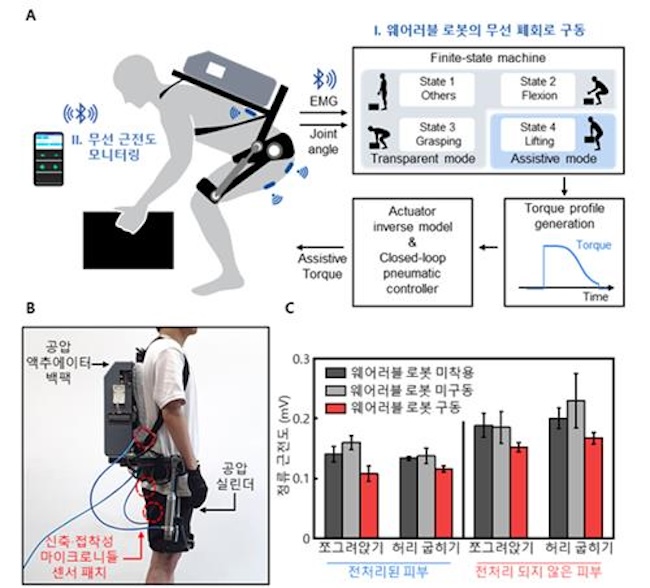
A breakthrough in myoelectric sensor technology has been developed for wearable robots used in rehabilitation treatments. (Image courtesy of Yonhap)
DAEJEON, Jan. 24 (Korea Bizwire) — A breakthrough in myoelectric sensor technology, capable of functioning efficiently amidst sweat and dead skin cells, has been developed for wearable robots used in rehabilitation treatments for the elderly, stroke survivors, and trauma patients.
This technology was developed by a joint research team led by professors Jeong Jae-woong from the Department of Electrical Engineering and Kim Jung from the BioRobotics Lab in the Department of Mechanical Engineering at KAIST (the Korea Advanced Institute of Science and Technology).
Wearable robots, utilized in various rehabilitation therapies, require accurate measurement of myoelectric signals generated by the body to understand the wearer’s movement intentions.
Traditional sensors often degrade in signal quality over time and are significantly affected by skin characteristics like hair, dead skin, and sweat, making reliable long-term control of wearable robots challenging.
To address this issue, the research team utilized a soft silicone polymer substrate to integrate microneedles, creating a stretchable and adhesive microneedle sensor. These firm microneedles can penetrate the skin’s tough outer layer, effectively reducing skin contact resistance.
This allows for high-quality electrophysiological signal reception even when the skin is contaminated with hair, dead skin, sweat, or other substances.
The sensor’s soft conductive adhesive substrate comfortably adapts to skin stretching caused by human movement, minimizing motion noise.
The team conducted experiments to confirm that the microneedle sensor patch enables stable myoelectric sensing and motion intention recognition, regardless of skin condition or the magnitude and type of physical movement. This ensures that wearable robots can effectively assist the user’s movements.
“The newly developed stretchable and adhesive microneedle sensor enables stable myoelectric sensing unaffected by skin conditions, facilitating more accurate and reliable control of wearable robots. This advancement will ease rehabilitation for patients using robotic assistance,” noted Jeong.
The research was published in the international academic journal ‘Science Advances’ on January 17.
Kevin Lee (kevinlee@koreabizwire.com)






